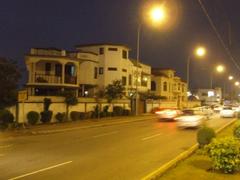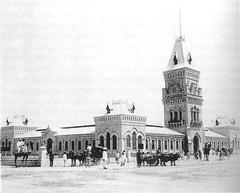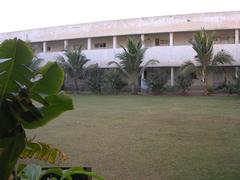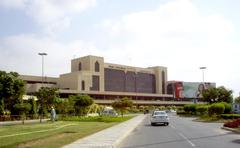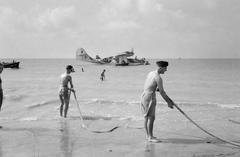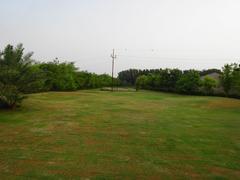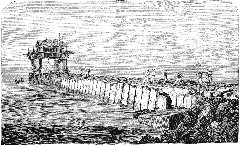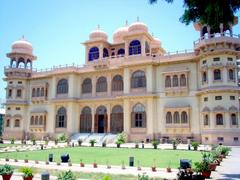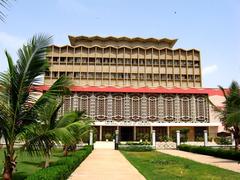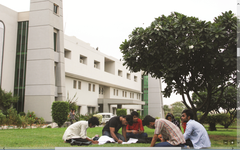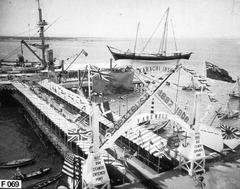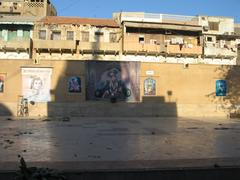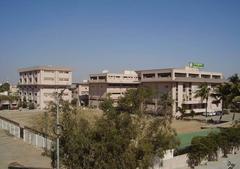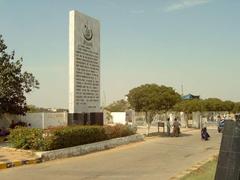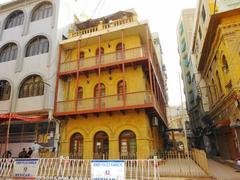Quaid-E-Azam House Karachi: Visiting Hours, Tickets, and Historical Sites Guide
Date: 15/06/2025
Introduction
Nestled in Karachi’s historic Saddar district, the Quaid-e-Azam House—also known as Flagstaff House—stands as a testament to the life and legacy of Muhammad Ali Jinnah, the founder of Pakistan. This late 19th-century colonial-era mansion, constructed by renowned architect Moses Somake, not only preserves Jinnah’s intimate living and working spaces but also serves as a vital educational and cultural resource. Visitors are welcomed into immaculately restored rooms filled with original furnishings, artifacts, and documents that narrate the story of Pakistan’s independence movement.
Strategically located near other iconic sites such as Frere Hall, Empress Market, and the National Museum of Pakistan, the Quaid-e-Azam House is essential for anyone exploring Karachi’s historical heritage. This guide provides everything you need for your visit: opening hours, ticket details, accessibility information, travel tips, insights into conservation efforts, and educational initiatives. Whether you are a history enthusiast or a casual traveler, the Quaid-e-Azam House offers a profound journey into the nation’s past (Sindh Tourism, Traveler Trails, Pakistan Travel Advisor).
Table of Contents
- Introduction
- Historical Background and Transformation
- Architectural Design and Features
- Cultural Significance
- Visiting Information: Hours, Tickets, and Accessibility
- Museum Collections and Exhibits
- Role in Pakistan’s Independence Movement
- Special Events and Educational Programs
- Visitor Experience and Practical Tips
- Safety, Etiquette, and Accessibility for International Tourists
- Conservation and Preservation Efforts
- Nearby Attractions and Amenities
- Frequently Asked Questions (FAQs)
- References and Further Reading
- Conclusion
Historical Background and Transformation
Origins and Early History
Constructed in 1868 by British architect Moses Somake, the Quaid-e-Azam House reflects the colonial influences of its era, with high ceilings, wide verandas, and intricate woodwork. Originally known as Flagstaff House, it was purchased by Muhammad Ali Jinnah in 1943 for 115,000 Indian Rupees—a significant investment that marked its transition from a colonial residence to a pivotal site in South Asian history. It quickly became a hub for political discussions and strategizing the future of the subcontinent.
Jinnah’s Residency (1944–1948)
Between 1944 and his death in 1948, Jinnah made Flagstaff House his residence and base of operations. It was here that he met with political leaders, diplomats, and dignitaries, shaping the policies that led to the birth of Pakistan. His sister, Fatima Jinnah, also lived here, remaining until 1964 and continuing to use the house as a center for intellectual and political activity.
Transition to a National Monument
Recognizing its historical significance, the Government of Pakistan acquired the property in the 1980s and converted it into the Flagstaff House Museum of Jinnah in 1984. Restoration efforts have since preserved its original structure and furnishings, offering visitors an immersive glimpse into the spaces where history was made.
Architectural Design and Features
Colonial-Era Construction
The house is a striking example of neoclassical colonial architecture, constructed from locally sourced limestone to withstand Karachi’s climate (Traveler Trails). Its grand façade, arched balconies, and carved pillars evoke a sense of dignity and permanence.
Layout and Interior Spaces
Spread over approximately 10,241 square yards, the residence features six main rooms—two bedrooms, two drawing rooms, a study, and a dining room. Authentic period details, such as arched balconies and carved woodwork, are preserved. The ground floor serves as the primary exhibition space, while upper areas (accessible via stairs) retain their historical character.
Gardens and Outdoor Spaces
The house is surrounded by lush gardens with indigenous plants and centuries-old trees, reflecting the colonial tradition of blending architecture with nature. The serene lawns offer a peaceful environment for reflection and photography.
Cultural Significance
Jinnah’s Legacy
As the residence of Muhammad Ali Jinnah, the site holds deep sentimental and historical value, symbolizing key decisions and moments during Pakistan’s founding years. Many original belongings—including furniture, photographs, and documents—remain on display (Trip.com).
National Monument and Museum
Since its conversion into a museum in 1985, the Quaid-e-Azam House has become a pilgrimage site for students, historians, and dignitaries, embodying Pakistan’s independence struggle and foundational ideals (TripJive, Paktoursguide).
Visiting Information: Hours, Tickets, and Accessibility
- Visiting Hours: Typically open Tuesday to Sunday, 10:00 AM to 5:00 PM. Closed Mondays and public holidays (Trip.com).
- Tickets: PKR 50 for Pakistani citizens, PKR 200 for foreign visitors, and free for children under 12. Prices and schedules can vary, so check the official museum website or tourism portals before your visit.
- Accessibility: The ground floor is wheelchair accessible, with ramps at the main entrance. Some upper areas may have limited access due to the building’s historic structure. Assistance is available upon request.
- Guided Tours: Available in English and Urdu; book in advance for group visits or educational programs.
Museum Collections and Exhibits
The museum boasts meticulously curated displays:
- Personal Artifacts: Jinnah’s clothing, furniture, walking sticks, glasses, and everyday items.
- Period Rooms: The study, dining room, bedroom, and Fatima Jinnah’s quarters, all arranged as they were during residency.
- Historic Documents and Photos: Letters, speeches, and rare photographs documenting Pakistan’s independence movement.
Exhibits are labeled in both English and Urdu, and interactive displays as well as audio guides are increasingly available.
Role in Pakistan’s Independence Movement
The Quaid-e-Azam House served as a key site where pivotal discussions and decisions regarding the partition of British India and the founding of Pakistan took place. Its preserved rooms and artifacts offer a tangible connection to the formative moments of the nation’s history.
Special Events and Educational Programs
The museum routinely organizes:
- Special Exhibitions: Thematic displays and temporary exhibits, especially around national holidays.
- Lectures and Workshops: Panel discussions, seminars, and workshops to promote historical understanding (thenews.com.pk).
- School Outreach: Field trips and interactive sessions for students (pakistantraveladvisor.com).
- Digital Outreach: Virtual tours and resources via the museum’s digital platforms (stdc.gos.pk).
Visitor Experience and Practical Tips
- Best Time to Visit: Weekday mornings are less crowded. Avoid midday heat.
- Dress Code: Modest attire is recommended.
- Photography: Allowed in gardens and exterior spaces; restricted inside to protect sensitive artifacts.
- Duration: Allocate 1–2 hours for a comprehensive visit.
- Language: Staff and guides speak both English and Urdu.
Safety, Etiquette, and Accessibility for International Tourists
- Safety: Security checks at the entrance; avoid carrying large bags.
- Etiquette: Maintain decorum, avoid loud conversations, and do not touch exhibits.
- International Visitors: English-language materials and guides are available. Ride-hailing apps like Careem and Uber are widely used for transport.
Conservation and Preservation Efforts
Significant investments have been made in:
- Structural Restoration: Termite control, moisture-resistant treatments, restoration of original materials, re-electrification, and climate control (antiquities.sindhculture.gov.pk).
- Artifact Preservation: Regular inspections, climate control, and trained staff ensure the longevity of personal and historical artifacts (graana.com).
- Security: Fire alarms, CCTV, alarms, and secure display cases are standard (antiquities.sindhculture.gov.pk).
Nearby Attractions and Amenities
- Frere Hall: Colonial-era architecture and cultural events.
- Empress Market: Iconic marketplace.
- Burns Road Food Street: Traditional Pakistani cuisine.
- National Museum of Pakistan: Expansive collections on Pakistani history (TravelSetu).
Frequently Asked Questions (FAQs)
Q: What are the Quaid-e-Azam House visiting hours?
A: Tuesday to Sunday, 10:00 AM to 5:00 PM. Closed Mondays and public holidays.
Q: How much are the tickets?
A: PKR 50 for locals, PKR 200 for foreigners, children under 12 free.
Q: Are guided tours available?
A: Yes, in English and Urdu. Book in advance for group tours.
Q: Is the museum wheelchair accessible?
A: The ground floor is accessible; some upper areas have limited access.
Q: Is photography allowed?
A: Permitted in outdoor areas; restricted inside.
References and Further Reading
- Quaid-e-Azam House Museum: Visiting Hours, Tickets, and Historical Significance in Karachi (Pakistan Travel Advisor)
- Visiting Quaid-e-Azam House: History, Tickets, and Hours at Karachi’s Iconic Museum (Traveler Trails)
- Quaid-e-Azam House Karachi: History, Visiting Hours, Tickets & More (Sindh Tourism)
- Conservation and Preservation Efforts (Antiquities Sindh)
- Exploring History: A Visit to Quaid-e-Azam House Museum (Graana Blog)
- Younger Generation Should Understand Why Pakistan Was Created (The News)
- Official Quaid-e-Azam House Museum Website
- GPSmyCity
- TravelSetu
- STDCP
Conclusion
The Quaid-e-Azam House Museum stands as an enduring symbol of Pakistan’s heritage, bridging the nation’s formative years with the present. Its well-preserved architecture, comprehensive collections, and dynamic educational programs make it essential for understanding the country’s past. Plan your visit, explore nearby cultural landmarks, and immerse yourself in the story of Pakistan’s founding father.
Download the Audiala app for interactive guides, and stay connected for updates and travel tips on Karachi’s rich historical landscape!
